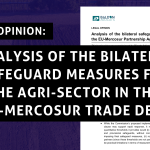POLICY BRIEF
Writen by Miłosława Stępień, Riccardo Nigro, Marta Anczewska
Overview
A recent report of the European Court of Auditors,[1] the guardian of the EU budget, highlights that despite the Polluter Pays Principle being one of the key principles underlying the European Union’s environmental policy, the EU budget is sometimes used to fund clean-up actions that, under the Polluter Pays Principle, should have been borne by polluters.The Polluter Pays Principle (PPP) is one of the biggest concerns in the implementation of just transition support, due to the complexity of the issue and the danger of misusing public funds. Attempts are being made to push financial responsibility for land restoration away from the companies that have profited from mining and fossil fuel-fired energy production and into the Just Transition Fund (JTF) and other related funds. This needs to be addressed as soon as possible, as not only should the JTF not bail polluters out of their responsibilities, but it should also be focused on answering other social priorities linked to the phase-out of carbon-intensive industries.
A stricter application of the PPP is needed, meaning that polluters should bear the costs of their pollution, including the cost of measures taken to prevent, control and remedy pollution, as well as the costs the polluters impose on society. By applying the principle, polluters are incentivised to avoid environmental damage and are held responsible for the pollution that they have caused. It is also the polluter, and not the taxpayer, who should cover the cost of remediation.
However, confusion in terms of PPP application within the just transition process will undermine the transition. This is a major concern for many stakeholders on the ground, such as the local authorities in coal regions, worried about the lack of suitable land restoration conducted in former mining areas. This apprehension also results from fears that polluting companies will find ways to avoid covering the environmental costs of the resource exploitation they benefited from. The Just Transition Fund and other related mechanisms should only be seen as a form of complementary funds to supplement obligatory restoration and rehabilitation processes, which should be covered financially by polluting entities in accordance with the Polluter Pays Principle. Although the JTF is a good resource for preparing and implementing repurposing projects, which the local communities are counting on, there need to be clear-cut rules to avoid any misappropriation of the available funds.
We are putting forward a diagnosis of the situation based on our analyses of the Territorial Just Transition Plans (TJTPs) in various CEE countries, prepared by Bankwatch and WWF national campaigners, various NGOs working on the ground throughout the coal regions, and also through the application of the WWF TJTP scorecards. This is followed by recommendations concerning the Polluter Pays Principle in the just transition process.
In a separate document prepared by the European Environmental Bureau, we propose a more concrete checklist that would enable ensuring PPP-compatible Territorial Just Transition Plans, which we strongly recommend applying to the just transition process.
1. Diagnosis
-
Identified problems in the Territorial Just Transition Plans (TJTPs)
Examples
Many of the already submitted TJTPs contain attempts at pushing financial responsibility for land restoration and rehabilitation away from the companies that have profited from mining. The Hunedoara region in Romania; the Western Małopolskie, Łódzkie, Upper Silesia and Eastern Wielkopolska regions, as well as the Wałbrzych sub-region in Poland; the Latvian just transition region; and the Ida-Virumaa region in Estonia have all been assessed by the WWF TJTP scorecard tool as at risk for directly contravening the Polluter Pays Principle by not identifying the entities responsible for existing environmental damage. Slovenia’s action plan is another example of such an issue.
In the two Hungarian counties (Heves and BAZ) of the Mátra Power Plant region, the repurposing of lignite mining areas is also an important part of the TJTPs. Out of a total JTF budget of about EUR 300 million in Hungary, about EUR 43 million would be allocated for alternative reclamation. However, the TJTPs do not include and do not expect any kind of Polluter Pays Principle-based assessment. In fact, the Polluter Pays Principle is not even mentioned in the text of the TJTPs. It should simultaneously be noted that if this amount were to be spent in full respect of the Polluter Pays Principle, specifically on repurposing preparation and implementation for the benefit of local communities, it would provide high added value to the just transition of the region.
Likewise, in the Western Małopolska region of Poland, the revitalisation of former mining sites is planned, with large utilities (i.e., Orlen, Tauron) as identified beneficiaries without a clear indication of an evaluation of the Polluter Pays Principle. Similarly, in Eastern Wielkopolska, the TJTP mentions providing funds for the restoration process and various projects at former mining sites belonging to the ZE PAK group. Information has also been made public that various mining-related companies have been rebudgeting their restoration funds to cover growing current expenses as a result of higher EU ETS costs.
More such specific examples can be found in the various TJTPs from all the CEE countries, which indicates that this is an issue that must be dealt with quickly and comprehensively due to the widespread character of the problem and its complexity.
Identified issues in the TJTPs related to the PPP
The plans do not include sufficient safeguards, as they recommend using JTF resources to pay for land restoration without any analysis – or commitment to undertake such an analysis – of the possibility, applicability and extent of the Polluter Pays Principle. There is a lack of clear rules and tools for how to do these necessary steps for limiting exploitation of the public funds offered within the JTF mechanism. This issue should be seen as a potential risk that could also apply to other available funds within the upcoming years, such as the Modernisation Fund or the Recovery and Resilience Facility.
For many municipalities, the current availability of JTF and structural funds is insufficient to tackle pollution and legacy problems from mining and related activities, which constitutes a barrier to just transition. Using these funds as a first resort would also contravene the Polluter Pays Principle. There is a need for technical assistance and legal guidance for municipalities to ensure that the polluters pay wherever and whenever they should do so. They also require expert support in planning repurposing projects (such as repurposing databases and evaluation matrixes) for their respective regions while making sure the Polluter Pays Principle is fully respected by the previous landowners.
Additionally, the plans frequently do not identify responsible polluters, as they lack a clear diagnosis of the situation that would take into account this aspect. A related issue results from situations in which the polluting entity no longer exists or is not solvent (such as in former Soviet states, e.g. Estonia, where Soviet Union institutions were responsible, referred to as ‘legacy pollution’) or is difficult to track or identify. In such cases, there is a need for restoration and rehabilitation processes to be introduced, but there are no clear guidelines within the JT mechanism concerning the extent to which it should be done by entities that have ‘inherited’ the responsibility. In terms of the just transition process, there is a lack of clear guidelines concerning whether such costs can be included as part of those eligible for financing from the JTF.
In turn, examples of open or undefined lists of large enterprises to receive JTF support for restoration measures are common, and it is also frequent for the plans to mention the transition to gas in various power plants (in itself an issue as a switch to another fossil fuel, which should not be covered by the JTF or any other EU funds)[2] without diagnosing whether this will side-line the Polluter Pays Principle. As an example, it is worth mentioning the case of Hungary, where a 500 MW combined cycle gas turbine (CCGT) power plant is planned for the Mátra power plant.[3] Will the costs resulting from the Polluter Pays Principle for damage caused by the coal-fired energy plant and related activities be covered in such a case, and by whom, if the power plant plans to switch to natural gas, causing new environmental damage? How will this be assessed?
A somewhat similar issue can be identified in reference to solar or wind power plants built on former mining sites. It is difficult to draw a clear line between reclaiming and landscaping before the new solar and wind utilities are actually introduced, but the just transition process should require detailed assessments of the expected extent of restoration work that should be covered by the polluting entity before any funds are given for new projects.
2. Recommendations
The Polluter Pays Principle is already present in the text of the Regulation; thus, the below recommendations primarily indicate the need for its enforcement in the just transition process.
OUR GENERAL RECOMMENDATIONS
-
While welcoming the clarifications provided by the Commission concerning the implementation of the TJTPs, a similar clarification document should be drafted to rightly enforce the PPP.
-
Such a document should insist on the fact that the TJTPS shall respect the PPP through the introduction of a mandatory check aimed at assessing which are the private entities liable for remediating environmental damages.
-
It could take the form of a practical checklist that shall be assessed before approving the TJTP (see Annex I). In particular, it should:
-
identify responsible polluters;
-
provide information about the obligations already set out for polluters in relevant documents at the national level (e.g. appropriate approved recultivation and landscape plans);
-
assess the extent of financial liabilities shouldered by the polluter according to relevant EU and national regulations;
-
provide information on the adherence of enterprises involved in the just transition process to the PPP, if they are to in any way be recipients of aid; and
-
create opportunities for alternative landscaping and repurposing.
-
-
In addition, we consider that it would be helpful for all those dealing with this issue if regional diagnoses were prepared by the European Commission concerning the pollution from carbon-intensive industries and the responsibilities that should be borne by polluting entities.
-
Technical assistance and legal guidance should be provided for municipalities, regions and national governments involved in the JT process to ensure that the Polluter Pays Principle is upheld.
-
Technical assistance should be provided for local and regional authorities on how they can work with existing landowners (e.g. polluters) and how they can plan and implement repurposing projects with maximum respect for the PPP.
-
The Just Transition mechanism must be supplied with appropriate safeguards to protect against misappropriation of public money in these regards.
-
Wherever new projects creating a lock-in to fossil fuels are envisaged (e.g. mining, coal, oil or gas exploitation), the Commission should not approve the plans by default. Similarly, to increase ambition, the Commission should expedite approval of TJTPs that foresee investments in sustainable, renewable and diversified energy projects.
-
We recommend that the Commission set out COM implementing rules/binding eligibility criteria, to be mirrored in the CEEAG, on how to enforce the Polluter Pays Principle and the ‘best value in the common interest for money’ principle. This is needed now; therefore, it should come before any review of the Environmental Liability Directive (ELD). This is crucial to ensure the best value of public funds used in the common interest.
-
In general, we strongly recommend a speedy revision of the ELD to ensure proper enforcement of the Polluter Pays Principle in future.
References
[1] European Court of Auditors, Special Report 12/2021: The Polluter Pays Principle: Inconsistent application across EU environmental policies and actions, 5 July 2021.
[2] There are plans to build this power plant using EU funds. Such a dual funding strategy, wherein certain EU funds explicitly ban investments in fossil fuel energy projects while other EU funds provide such support, should not be allowed.
[3] Mátra Energia, Our vision, Mátra Energia, accessed 7 October 2021.
Download the full policy brief with annex.



